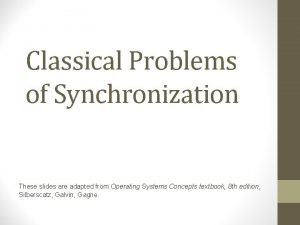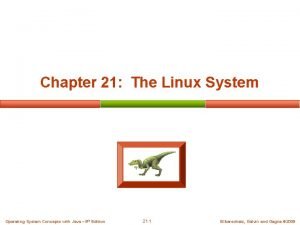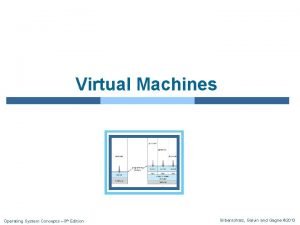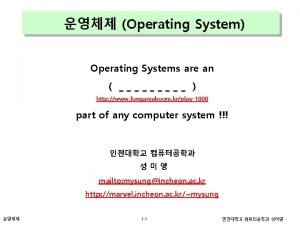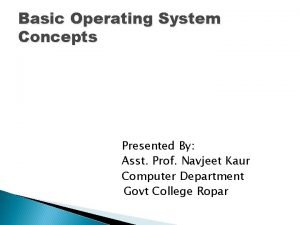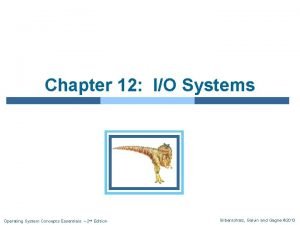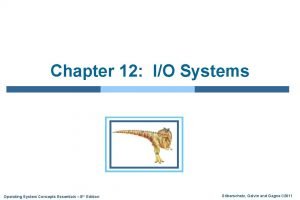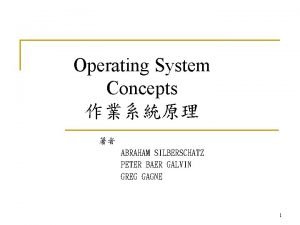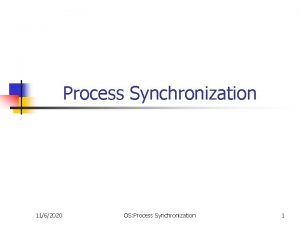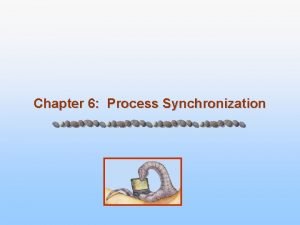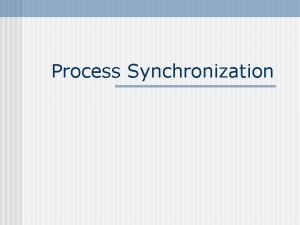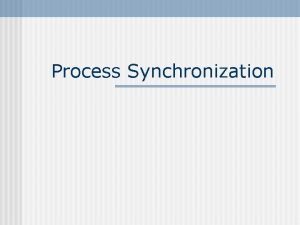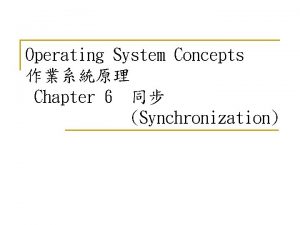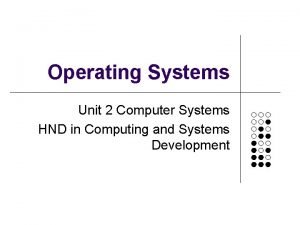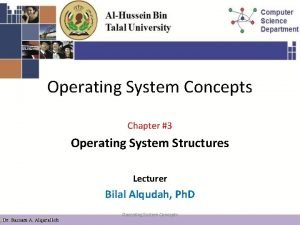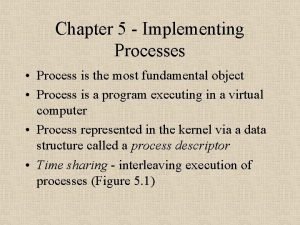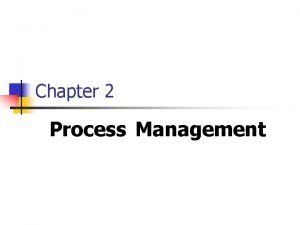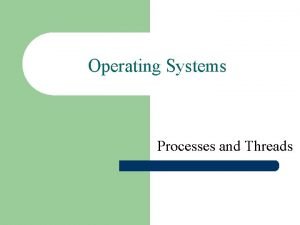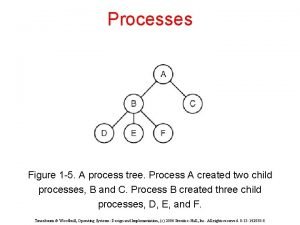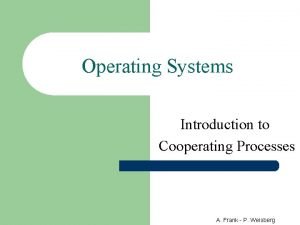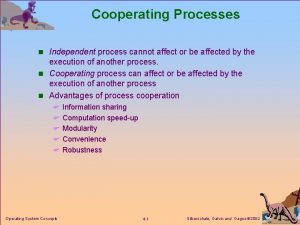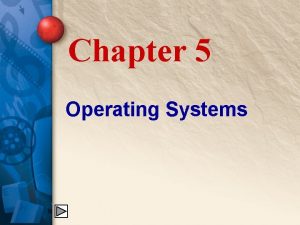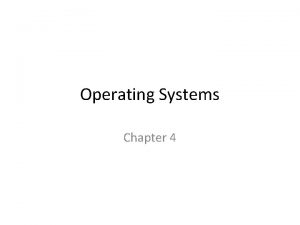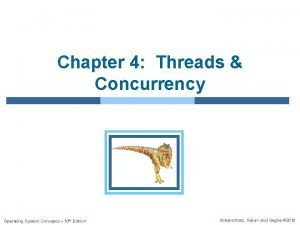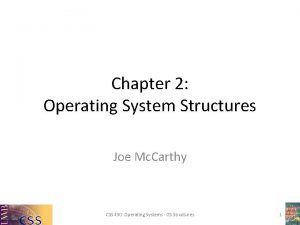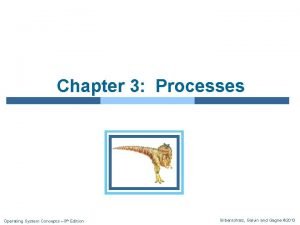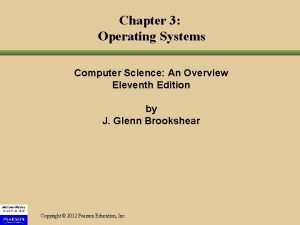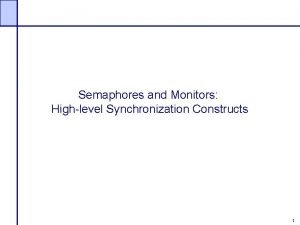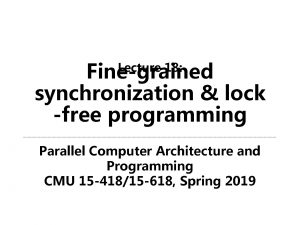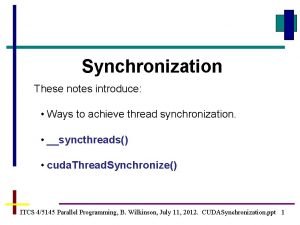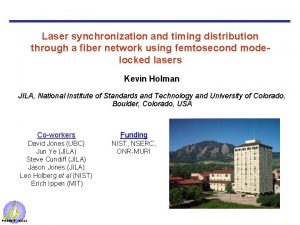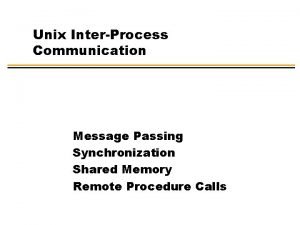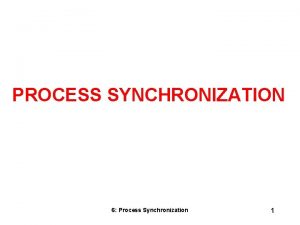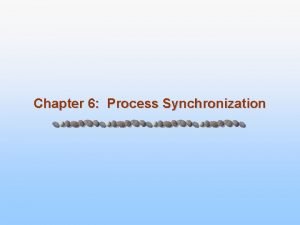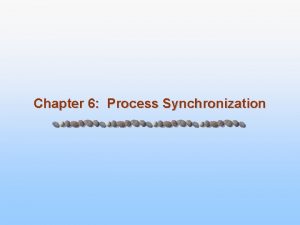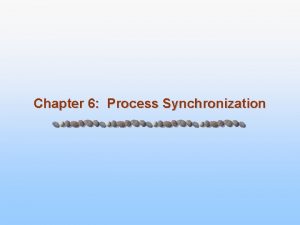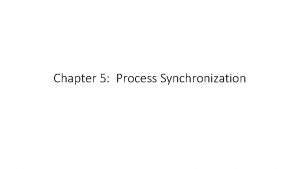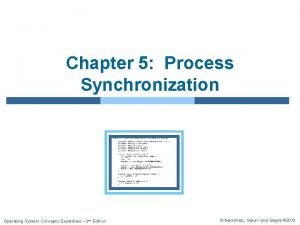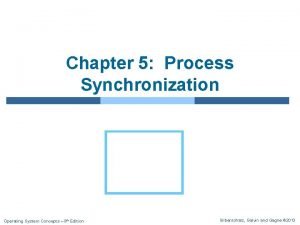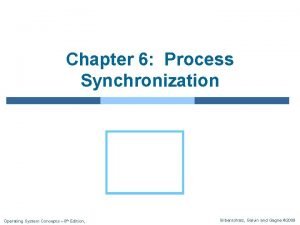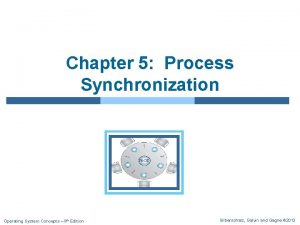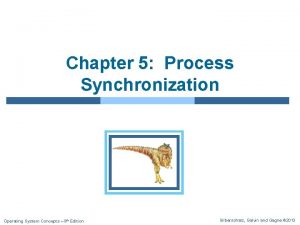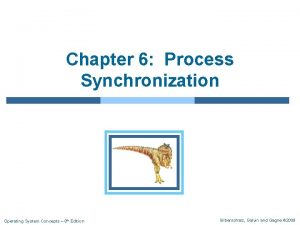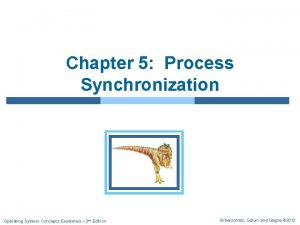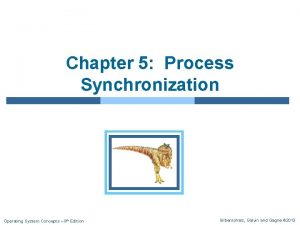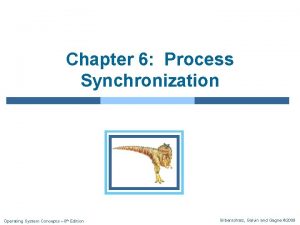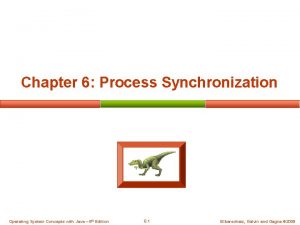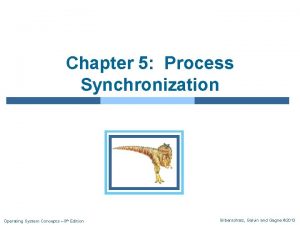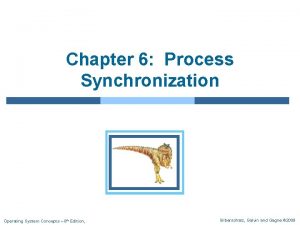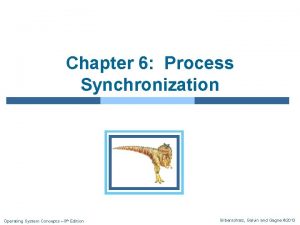Chapter 5 Process Synchronization Operating System Concepts 9


















![Critical-Section Problem: Peterson’s Solution l Each Pi enters its CS only if either (flag[j] Critical-Section Problem: Peterson’s Solution l Each Pi enters its CS only if either (flag[j]](https://slidetodoc.com/presentation_image_h/1e4ede0c3bf832d074a437f6895cc877/image-19.jpg)








































- Slides: 59

Chapter 5: Process Synchronization Operating System Concepts – 9 th Edition Silberschatz, Galvin and Gagne © 2013

Chapter 5: Process Synchronization n n n n Background The Critical-Section Problem Peterson’s Solution Synchronization Hardware Mutex Locks Semaphores Classic Problems of Synchronization Examples Alternative Approaches Operating System Concepts – 9 th Edition 5. 2 Silberschatz, Galvin and Gagne © 2013

Objectives n To present the concept of process synchronization. n To introduce the critical-section (CS) problem, whose solutions can be used to ensure the consistency of shared data n To present both software and hardware solutions of the critical-section problem n To examine several classical process-synchronization problems n To explore several tools that are used to solve process synchronization problems Operating System Concepts – 9 th Edition 5. 3 Silberschatz, Galvin and Gagne © 2013

Background n Processes can execute concurrently l May be interrupted at any time, partially completing execution n Concurrent access to shared data may result in data inconsistency l Maintaining data consistency requires mechanisms to ensure the orderly execution of cooperating processes 4 Illustration of the problem: Suppose that we wanted to provide a solution to the consumerproducer problem that fills all the buffers. 4 an integer counter that keeps track of the number of full buffers. 4 Initially, counter is set to 0. It is incremented by the producer after it produces a new buffer location and is decremented by the consumer after it consumes a buffer. Operating System Concepts – 9 th Edition 5. 4 Silberschatz, Galvin and Gagne © 2013

Producer while (true) { /* produce an item in next produced */ while (counter == BUFFER_SIZE) ; /* do nothing */ buffer[in] = next_produced; in = (in + 1) % BUFFER_SIZE; counter++; } Operating System Concepts – 9 th Edition 5. 5 Silberschatz, Galvin and Gagne © 2013

Consumer while (true) { while (counter == 0) ; /* do nothing */ next_consumed = buffer[out]; out = (out + 1) % BUFFER_SIZE; counter--; /* consume the item in next consumed */ } Operating System Concepts – 9 th Edition 5. 6 Silberschatz, Galvin and Gagne © 2013

Race Condition n counter++ could be implemented as register 1 = counter register 1 = register 1 + 1 counter = register 1 n counter-- could be implemented as register 2 = counter register 2 = register 2 - 1 counter = register 2 Operating System Concepts – 9 th Edition 5. 7 7 Silberschatz, Galvin and Gagne © 2013

Race Condition Operating System Concepts – 9 th Edition 5. 8 8 Silberschatz, Galvin and Gagne © 2013

Producer-Consumer Problem: Race condition n We would arrive at this incorrect state because we allowed both processes to manipulate the variable counter concurrently. n A situation like this, where several processes access and manipulate the same data concurrently and the outcome of the execution depends on the particular order in which the access takes place, is called a race condition. n To guard against the race condition we need to ensure that only one process at a time can be manipulating the variable counter. Operating System Concepts – 9 th Edition 5. 9 Silberschatz, Galvin and Gagne © 2013

Principles of Concurrency-Race condition l Suppose that two processes P 1 and P 2 share the global variable a. At some point in its execution, P 1 updates a to the value 1, and at some point in its execution, P 2 updates a to the value 2. Thus, the two tasks are in a race to write variable a. 4 In this example, the process that updates last determines the final value of a. l Consider two processes, P 3 and P 4, that share global variables b and c, with initial values b = 1 and c = 2. At some point in its execution, P 3 executes b = b + c and at some point in its execution, P 4 executes c = b + c. 4 The final values of the two variables depend on the order in which the two processes execute their assignments. 4 If P 3 executes its assignment first, then b = 3 and c = 5. 4 If P 4 executes its assignment first, then b = 4 and c = 3. Operating System Concepts – 9 th Edition 5. 10 Silberschatz, Galvin and Gagne © 2013

Critical Section (CS) n A critical section (CS) is a code segment in a process in which a shared resource is allowed to access: l Only one process can execute its CS at any one time l When no process is executing in its CS , any process that requests entry to its CS must be permitted without delay l When two or more processes compete to enter their respective CSs , the selection cannot be postponed indefinitely l No process can prevent any other process from entering its CS indefinitely l Every process should be given a fair chance to access the shared resource through CS Operating System Concepts – 9 th Edition 5. 11 Silberschatz, Galvin and Gagne © 2013

CS Problem n Consider system of n processes {p 0, p 1, … pn-1} n Each process has CS segment l Process may be changing common variables, updating table, writing file, etc l When one process in CS, no other may be in its CS l Each process must ask permission to enter CS in entry section, may follow critical section with exit section, then remainder section. l The general structure of a typical process Pi is shown in Figure 5. 1. l No two processes are executing in their critical sections at the same time. Operating System Concepts – 9 th Edition 5. 12 Silberschatz, Galvin and Gagne © 2013

CS n General structure of process Pi Operating System Concepts – 9 th Edition 5. 13 Silberschatz, Galvin and Gagne © 2013

Solution to CS Problem 1. Mutual Exclusion - If process Pi is executing in its critical section (CS), then no other processes can be executing in their critical sections 2. Progress - If no process is executing in its CS and there exist some processes that wish to enter their CS, then the selection of the processes that will enter the CS next cannot be postponed indefinitely 3. Bounded Waiting - A bound must exist on the number of times that other processes are allowed to enter their critical sections after a process has made a request to enter its critical section and before that request is granted Assume that each process executes at a nonzero speed No assumption concerning relative speed of the n processes Operating System Concepts – 9 th Edition 5. 14 Silberschatz, Galvin and Gagne © 2013

CS Handling in OS Two approaches depending on if kernel is preemptive or non- preemptive l Preemptive – allows preemption of process when running in kernel mode 4 Preemptive kernels are especially difficult to design for SMP architectures, since in these environments it is possible for two kernel-mode processes to run simultaneously on different processors. l Non-preemptive – runs until exits kernel mode, blocks, or voluntarily yields CPU 4 Essentially free of race conditions in kernel mode, as only one process is active in the kernel at a time. Operating System Concepts – 9 th Edition 5. 15 Silberschatz, Galvin and Gagne © 2013

Critical-Section Handling in OS n Why, then, would anyone favor a preemptive kernel over a non-preemptive one? l A preemptive kernel may be less risk that a kernel-mode process can run for an arbitrarily long period before relinquishing it by the processor. l A preemptive kernel is more suitable for real-time programming, as it will allow a real-time process to preempt a process currently running in the kernel. Operating System Concepts – 9 th Edition 5. 16 Silberschatz, Galvin and Gagne © 2013

Critical-Section Problem: Peterson’s Solution n Peterson’s solution to CS problem is restricted to two processes that alternate execution between their critical sections and remainder sections. The processes are numbered Pi and Pj (where i = 0 and j = 1) l Figure 5. 2 The structure of process in Peterson’s solution. l l int turn; 4 The – l integer variable turn indicates whose turn it is to enter its CS. if turn == i, then process Pi is allowed to execute in its CS boolean flag[2]; 4 A size two array is used to indicate if a process is ready to enter its CS. 4 For example, if flag[i] is true, this value indicates that P i is ready to enter its critical section. Operating System Concepts – 9 th Edition i 5. 17 1 Silberschatz, Galvin and Gagne © 2013

Critical-Section Problem: Peterson’s Solution Operating System Concepts – 9 th Edition 5. 18 1 Silberschatz, Galvin and Gagne © 2013
![CriticalSection Problem Petersons Solution l Each Pi enters its CS only if either flagj Critical-Section Problem: Peterson’s Solution l Each Pi enters its CS only if either (flag[j]](https://slidetodoc.com/presentation_image_h/1e4ede0c3bf832d074a437f6895cc877/image-19.jpg)
Critical-Section Problem: Peterson’s Solution l Each Pi enters its CS only if either (flag[j] == false ) or (turn == Pi ), where Pi = 0 l If (flag[i] == flag[j] == true), then it imply that Pi and Pj could not have successfully executed their while statements at about the same time, since the value of turn can be either 0 or 1 but cannot be both. So this situation is not valid! l If (flag[j] == true and turn == Pj), and this condition will cause Pj is in its critical section, where Pj = 1 l If Pj is not ready to enter its CS, then (flag[j] == false), and Pi can enter its CS. l Mutual exclusion is preserved Pi enters CS only if: either flag[j] = false or turn = i Code in C++ Simulation Operating System Concepts – 9 th Edition 5. 19 1 Silberschatz, Galvin and Gagne © 2013

Critical Section n General structure of process Pi Operating System Concepts – 9 th Edition 5. 20 2 Silberschatz, Galvin and Gagne © 2013

Solution to CS: mutual exclusion locks n OS designers build software tools to solve CS problem, simplest is mutex lock (called mutual exclusion lock) to protect critical regions and thus prevent race conditions. n That is, a process must acquire the lock before entering a CS; it releases the lock when it exits the CS. l Protect a CS by first acquire() a lock then release() the lock; do { acquire lock critical section release lock remainder section } while (TRUE); Operating System Concepts – 9 th Edition 5. 21 Silberschatz, Galvin and Gagne © 2013

Mutex Locks Operating System Concepts – 9 th Edition 5. 22 2 Silberschatz, Galvin and Gagne © 2013

Disadvantage of Mutex Locks n The main disadvantage of mutex lock is that it requires busy waiting (spinlock) l Spinlock means processors continuously execute the atomic instruction to check for the status of the shared variable 4 It wastes processor cycles and consumes network bandwidth n While a process is in its CS, any other process that tries to enter its CS must loop continuously in the call to acquire(). n Calls to acquire() and release() must be atomic n But this solution requires busy waiting n This lock therefore called a spinlock Operating System Concepts – 9 th Edition 5. 23 2 Silberschatz, Galvin and Gagne © 2013

Atomic hardware instructions for Critical Section n Atomic HW instructions for CS through mutex are: l Test-and-Set () instruction l Compare-and-Swap() Instruction Operating System Concepts – 9 th Edition 5. 24 2 Silberschatz, Galvin and Gagne © 2013

Atomic hardware instructions for Critical Section (mutex) n Test-and-Set () instruction 4 “Test” the requested process is sanctioned to enter CS by checking a memory location or a Boolean variable 4 If yes (the memory location match), then “Set” the selected process for CS n The Test-and -Set() instruction can be defined as shown in Figure 5. 3. l If the machine supports the test and set() instruction, then we can implement mutex by declaring a boolean variable lock, initialized to false. Operating System Concepts – 9 th Edition 5. 25 2 Silberschatz, Galvin and Gagne © 2013

test and set() instruction 1. Executed atomically 2. Returns the original value of passed parameter 3. Set the new value of passed parameter to “TRUE”. 1. Executed atomically 2. Returns the original value of passed parameter *target and set it as true Operating System Concepts – 9 th Edition 5. 26 2 Silberschatz, Galvin and Gagne © 2013

compare_and_swap Instruction int compare _and_swap(int *value, int expected, int new_value) { int temp = *value; if (*value == expected) *value = new_value; return temp; } 1. Executed atomically 2. Returns the original value of passed parameter “*value” – a shared variable 3. If *value and expected are same, then assigns new_value to *value and return *value. That is, the swap takes place only under this condition. Operating System Concepts – 9 th Edition 5. 27 2 Silberschatz, Galvin and Gagne © 2013

Semaphores n Mutex locks, are generally considered the simplest of process synchronization tools. n A semaphore is a more robust synchronization tool that provides more sophisticated ways (than Mutex locks) for process synchronization. n A semaphore S is an integer variable that, apart from initialization, is accessed only through two standard atomic operations: l wait() l signal() Operating System Concepts – 9 th Edition 5. 28 Silberschatz, Galvin and Gagne © 2013

Semaphores n The wait() operation was originally termed P (“to test”). n The definition of wait() is as follows: P(S) or wait(S): send a wait to waiting processes until the S access operation (S = S - 1)by the current process(s) has been completed. n The signal() was originally called V (“to increment ”). n The definition of signal() is as follows: V(S) or signal(S): Signal a waiting process if the previous process has been released all S by incrementing (S = S + 1)it. Operating System Concepts – 9 th Edition 5. 29 Silberschatz, Galvin and Gagne © 2013

Semaphores Operating System Concepts – 9 th Edition 5. 30 Silberschatz, Galvin and Gagne © 2013

Semaphores P(S) Semaphore S; // initialize resource size S { while (S > 0) ; // wait until resource accessed S = S - 1; // resource access } V(S) Semaphore S; // initialize resource size S { S = S+1; // free resources by processes } Init(S, v) // initialize S with v values before a new request Semaphore S; // initialize resource size S Int v; { S = v; } Operating System Concepts – 9 th Edition 5. 31 Silberschatz, Galvin and Gagne © 2013

Semaphores n All modifications to the integer value of the semaphore in the wait() and signal() operations must be executed indivisibly. l That is, when one process modifies the semaphore value, no other process can simultaneously modify that same semaphore value. n In addition, in the case of wait(S), the testing of the integer value of S (S ≤ 0), as well as its possible modification (S--), must be executed without interruption. Operating System Concepts – 9 th Edition 5. 32 Silberschatz, Galvin and Gagne © 2013

Semaphore Usage n Operating systems often distinguish between counting and binary semaphores. n The value of a counting semaphore can range over an unrestricted domain. n The value of a binary semaphore can range only between 0 and 1. l Thus, binary semaphores behave similarly to mutex locks. 4 on systems that do not provide mutex locks, binary semaphores can be used instead for providing mutual exclusion. Operating System Concepts – 9 th Edition 5. 33 Silberschatz, Galvin and Gagne © 2013

Semaphores n Use semaphores to solve synchronization problems: For example, consider two concurrently running processes: l P 1 with a statement S 1 and P 2 with a statement S 2. Suppose we require that S 2 be executed only after S 1 has completed. l We can implement this scheme readily by letting P 1 and P 2 share a common semaphore synch, initialized with its size. l In process P 1, we insert the statement S 1; wait(synch); // P 1 using semaphore synch (P 1 in CS) and P 2 should wait l In process P 2, we insert the statements: signal(synch); // Signal to P 2 indicates P 1 has completed its semaphore synch (means, its CS). Operating System Concepts – 9 th Edition 5. 34 Silberschatz, Galvin and Gagne © 2013

Semaphores n Possibly the simplest use for a semaphore is signaling l Means that one thread sends a signal to another thread to indicate that something has happened l Signaling makes it possible to guarantee that one thread will run CS before another thread l Assume that semaphore s with initial value 0 (no resource available), and that Threads A and B have shared access to it Thread-A Thread-B t 1. statement a 1 (in CS) t 2. s. signal() t 1. s. wait() t 2. statement b 1 (in CS) l 4 At time t 1, Thread. A in CS and Thread. B in waiting state 4 At time t 2, Thread. A frees s and Thread. B gets s (in its CS) The semaphore guarantees that Thread-A has completed a 1 before Thread-B begins b 1 Operating System Concepts – 9 th Edition Dr. Anilkumar K. G 5. 35 3 Silberschatz, Galvin and Gagne © 2013

Semaphores - Puzzle Thread A 1 statement a 1 2 Statement a 2 Thread B 1 Statement b 1 2 Statement b 2 n Given this code we want to guarantee that a 1 happens before b 2 and b 1 happens before a 2 (Hint: use semaphores as like the previous example. Don’t forget to specify the names and initial values of your semaphores) Operating System Concepts – 9 th Edition Dr. Anilkumar K. G 5. 36 3 Silberschatz, Galvin and Gagne © 2013

Semaphores – Puzzle Answer Thread A t 1: t 2: t 3: t 4: t 5: a 1(in CS) a 1. signal a 2. wait a 2 (in CS) a 2. signal Thread B t 1: b 1. wait t 2: b 1(in CS) t 3: b 1. signal t 4: b 2. wait t 5: b 2 (in CS) Dr. Anilkumar K. G Operating System Concepts – 9 th Edition 5. 37 37 Silberschatz, Galvin and Gagne © 2013

Semaphores n Advantages l Semaphores impose deliberate constraints that help programmers to avoid errors l Solutions using semaphores are often clean and organized l Semaphore can be implemented efficiently on many systems, so solutions that use semaphores are portable and usually efficient Operating System Concepts – 9 th Edition 5. 38 3 Silberschatz, Galvin and Gagne © 2013

Semaphores n Drawbacks l A process that uses a semaphore has to know which other processes use the semaphore (or waiting for semaphore) 4 the semaphore operations of all interacting processes have to be coordinated l Semaphore operations must be carefully positioned in a process 4 The omission of a P or V operation may result in deadlock or inconsistencies l Programs with semaphores extremely hard to verify for their correctness Operating System Concepts – 9 th Edition 5. 39 Silberschatz, Galvin and Gagne © 2013

Deadlock and Starvation n Deadlock – two or more processes are waiting indefinitely for an event that can be caused by only one of the waiting processes n Let S and Q be two semaphores initialized to 1 P 0 P 1 wait(S); wait(Q); wait(S); . . . signal(S); signal(Q); signal(S); n Suppose that P 0 executes wait(S) and then P 1 executes wait(Q). When P 0 executes wait(Q), it must wait until P 1 executes signal(Q). n Similarly, when P 1 executes wait(S), it must wait until P 0 executes signal(S). Since these signal() operations cannot be executed, P 0 and P 1 are deadlocked. Operating System Concepts – 9 th Edition 5. 40 Silberschatz, Galvin and Gagne © 2013

Deadlock and Starvation n Starvation – indefinite blocking l A process may never be removed from the semaphore queue in which it is suspended n Priority Inversion – Scheduling problem when lower- priority process holds a lock needed by higher-priority process l Solved via priority-inheritance protocol Operating System Concepts – 9 th Edition 5. 41 Silberschatz, Galvin and Gagne © 2013

Classical Problems of Synchronization n Classical problems used to test newly-proposed synchronization schemes l Bounded-Buffer Problem l Readers and Writers Problem l Dining-Philosophers Problem Operating System Concepts – 9 th Edition 5. 42 Silberschatz, Galvin and Gagne © 2013

Bounded-Buffer Problem n n buffers, each can hold one item n Semaphore mutex initialized to the value 1 n Semaphore full initialized to the value 0 n Semaphore empty initialized to the value n Operating System Concepts – 9 th Edition 5. 43 Silberschatz, Galvin and Gagne © 2013

The Producer-Consumer - Semaphore n The structure of the producer process do {. . . /* produce an item in next_produced */. . . wait(empty); wait(mutex); . . . /* add next produced to the buffer */. . . signal(mutex); signal(full); } while (true); Operating System Concepts – 9 th Edition 5. 44 Silberschatz, Galvin and Gagne © 2013

The Producer-Consumer - Semaphore n The structure of the consumer process Do { wait(full); wait(mutex); . . . /* remove an item from buffer to next_consumed */. . . signal(mutex); signal(empty); . . . /* consume the item in next consumed */. . . } while (true); Operating System Concepts – 9 th Edition 5. 45 Silberschatz, Galvin and Gagne © 2013

The Producer-Consumer - Semaphore n The structure of the producer process do { // produce an item wait (empty); // consumer should wait because buffer is empty wait (mutex); // consumer wait, mutex semaphore is with producer add the item to the buffer; // fill buffer (CS) signal (mutex); // signal to consumer that ‘mutex’ is free and get it signal (full); // signal to consumer that buffer is full } while (TRUE); n The structure of the consumer process do { wait (full); // producer wait because buffer is full wait (mutex); // producer wait ‘mutex’ is with consumer remove an item from buffer; // consume buffer (CS) signal (mutex); // signal to producer that mutex is free and get it signal (empty); // signal to producer that buffer is empty } while (TRUE); Operating System Concepts – 9 th Edition 5. 46 4 Silberschatz, Galvin and Gagne © 2013

The Producer-Consumer problem n In multithreaded programs there is often a division of labor between processes (or threads) n And some processes are producers and some are consumers l Producers create items of some kind add them to a data structure (buffer); l Consumers remove (consume) the items from buffer and process them Operating System Concepts – 9 th Edition 5. 47 4 Silberschatz, Galvin and Gagne © 2013

Producer-Consumer Problem n There are several synchronization constraints that we need to enforce to make this producer-consumer system work correctly l Producer processes (or threads) supplies/produce messages l Consumer processes ( or threads) consume messages l Both processes (asynchronous in nature) share a common buffer l conditional synchronization as well as mutual exclusion needed: 4 No consumer can access the buffer when it is empty and no producer can access the buffer when it is full 4 If a consumer process (or thread) arrives while the buffer is empty, it blocks until a producer adds a new item into it Operating System Concepts – 9 th Edition 5. 48 4 Silberschatz, Galvin and Gagne © 2013

Producer-Consumer Problem n Event-driven programs are a good example: l Whenever and event occurs, a producer thread creates an event object and adds it to the event buffer l Concurrently, consumer threads take events out of the buffer and execute them l In this case, the consumers are called “event handlers” Operating System Concepts – 9 th Edition 5. 49 4 Silberschatz, Galvin and Gagne © 2013

Readers-Writers Problem n Here a data set is shared among a number of concurrent processes l Readers – only read the data set; they do not perform any updates l Writers – can both read and write n Problem – allow multiple readers to read at the same time and only one single writer can access the shared data at the same time. n Several variations of how readers and writers are considered – all involve some form of priorities n Shared Data l Data set l Semaphore rw_mutex initialized to 1 l Semaphore mutex initialized to 1 l Integer read_count initialized to 0 Operating System Concepts – 9 th Edition 5. 50 Silberschatz, Galvin and Gagne © 2013

Readers-Writers Problem (Cont. ) n The structure of a writer process do { wait(rw_mutex); . . . /* writing is performed */. . . signal(rw_mutex); } while (true); Operating System Concepts – 9 th Edition 5. 51 Silberschatz, Galvin and Gagne © 2013

Readers-Writers Problem (Cont. ) n The structure of a reader process do { // first finding readers using ‘mutex’ wait(mutex); // reader gets ‘mutex’ means a writer waits read_count++; // check no. of readers if (read_count == 1) //if at least one reader wait(rw_mutex); // then writer waits signal(mutex); // else signal mutex to write(no readers). . . /* reading is performed */. . . wait(mutex); // Still reading is going on (means writer waits) read count--; // reading by readers one by one if (read_count == 0) // if no more readers signal(rw_mutex); // signal ‘rw_mutex’ to writers to synch signal(mutex); // signal ‘mutex’ to synchronized writers } while (true); Operating System Concepts – 9 th Edition 5. 52 Silberschatz, Galvin and Gagne © 2013

The Dining Philosophers (cont. ) l Five philosophers are sitting in a circle, attempting to eat spaghetti with the help of forks l Each philosopher has a bowl of spaghetti but there are only five forks (forks are placed between left and right of each philosopher) to share among them l But both forks are needed at a time to consume spaghetti l A philosopher alternates between two phases: 4 Thinking and eating l In the thinking mode, a philosopher does not hold a fork l When hungry, a philosopher attempts to pick up both forks on left and right sides 4 A philosopher can start eating only after obtaining both forks 4 Once start eating the forks are not relinquished until the eating phase is over Operating System Concepts – 9 th Edition 5. 53 5 Silberschatz, Galvin and Gagne © 2013

The Dining Philosophers (cont. ) n Note that no two neighboring philosophers can eat simultaneously n In order to find any solution, the act of picking up a fork by a philosopher must be a critical section n The solution should be a deadlock free one, in which no philosopher starves Operating System Concepts – 9 th Edition 5. 54 5 Silberschatz, Galvin and Gagne © 2013

The Dining Philosophers (cont. ) n Five philosophers, who represent interacting threads, come to the table and execute the following loop: while true think() get_forks() eat() put_forks() The program should satisfy the following constraints: 1. Only one philosopher can hold a fork at a time. 2. It must be impossible for a deadlock to occur. 3. It must be impossible for a philosopher to starve waiting for a fork. 4. It must be possible for more that one philosopher to eat at the same time. Operating System Concepts – 9 th Edition 5. 55 5 Silberschatz, Galvin and Gagne © 2013

Windows Synchronization n Windows uses interrupt masks to protect access to global resources on uniprocessor systems. n Uses spinlocks on multiprocessor systems l Spinlocking-thread will never be preempted n Also provides dispatcher objects user-land which may act as mutexes, semaphores, events, and timers l Events 4 An event acts much like a condition variable l Timers notify one or more thread when time expired l Dispatcher objects either signaled-state (object available) or nonsignaled state (thread will block) Operating System Concepts – 9 th Edition 5. 56 Silberschatz, Galvin and Gagne © 2013

Linux Synchronization n Linux: l Prior to kernel Version 2. 6, disables interrupts to implement short critical sections l Version 2. 6 and later, fully preemptive n Linux provides: l Semaphores l atomic integers l spinlocks l reader-writer versions of both n On single CPU system, spinlocks replaced by enabling and disabling kernel preemption. Operating System Concepts – 9 th Edition 5. 57 Silberschatz, Galvin and Gagne © 2013

n #include <cstdlib> n #include <iostream> n #include <string> n #include <time. h> n #include<windows. h> n using namespace std; n void delay() n { time_t start_time, cur_time; n time(&start_time); n do{ time(&cur_time); } n while((cur_time - start_time) < 2. 5); // 2. 5 ms delay n } n int main(int argc, char *argv[]) n { n bool flag[2]= {false, false}; n int turn; n int count = 1; n int bount = 1; n string turn. Val; n do{ n system("CLS"); n srand (time(NULL)); n int ran = rand() % 2; // generate 0 = i or 1 = j n flag[ran] = true; // i == true n turn = ran; //j = 1 n while(flag[ran] && turn == ran)// while both flag and turn are same then n { n cout << "nn"; n for (int i = 0; i < 2; i++) n { if (i == 0 && flag[i] == 1) {cout << " flag[Pi] = true " ; } n else if(i == 0 && flag[i] == 0){cout << " flag[Pi] = false " ; } n else if(i == 1 && flag[i] == 1){cout << " flag[Pj] = true "; } n else {cout << " flag[Pj] = false "; }}//for ends n if(turn == 0)turn. Val = " Pi ( value is 0) "; n else turn. Val = " Pj (value is 1) "; n cout << " turn = " << turn. Val << endl; n if(ran == 0) // print the equivalent process critical status n { if (count == 1) n {Beep(1568, 300); //cout << 'a'; // window beep n count = 0; } n cout << "n =======================n"; n cout << " n Process Pi is in its Critical Section (CS). n"; n cout << "n =======================n" ; n bount = 1; } n else { if(bount == 1){ n Beep(1275, 400); //cout << 'a'; // window beep n bount = 0; } n cout << "n =======================n"; n cout << " n Process Pj is in its Critical Section (CS). n"; n cout << "n =======================n" ; n count = 1; n } n flag[ran] = false; // clear the flag status for next process n delay(); // call 2 ms delay n }while(true); n system("PAUSE"); n return EXIT_SUCCESS; th 5. 58 Operating System Concepts – 9 Edition n } BACK 5 Silberschatz, Galvin and Gagne © 2013

End of Chapter 5 Operating System Concepts – 9 th Edition Silberschatz, Galvin and Gagne © 2013
 Classical problems of synchronization in operating system
Classical problems of synchronization in operating system Synchronization tools in operating system
Synchronization tools in operating system Which one of the following is a synchronization tool?
Which one of the following is a synchronization tool? Operating system concepts chapter 8 solutions
Operating system concepts chapter 8 solutions Operating system concepts chapter 5 solutions
Operating system concepts chapter 5 solutions Operating system concepts chapter 5 solutions
Operating system concepts chapter 5 solutions Operating system
Operating system Linux operating system concepts
Linux operating system concepts Operating system concepts with java
Operating system concepts with java Operating system concepts 6th edition
Operating system concepts 6th edition Operating system concepts 9
Operating system concepts 9 Real time operating system concepts
Real time operating system concepts 교보 drm
교보 drm Basic operating system concepts
Basic operating system concepts Operating system concepts 11th
Operating system concepts 11th Operating system concepts essentials
Operating system concepts essentials Operating system concepts essentials
Operating system concepts essentials Silberschatz operating system concepts
Silberschatz operating system concepts Process synchronization in os
Process synchronization in os Process synchronization in os
Process synchronization in os Process synchronization definition
Process synchronization definition Process synchronization definition
Process synchronization definition Chapter
Chapter Physical clock synchronization in distributed system
Physical clock synchronization in distributed system Operating systems
Operating systems Process management in operating system
Process management in operating system Process management in operating system
Process management in operating system Implementation of process in operating system
Implementation of process in operating system Process management in operating system
Process management in operating system Threads in operating system
Threads in operating system Process tree in operating system
Process tree in operating system Race condition
Race condition Process description and control in operating system
Process description and control in operating system Cooperating process
Cooperating process Buddy system memory
Buddy system memory File system in operating system
File system in operating system File system in operating system
File system in operating system File system in operating system
File system in operating system Operating system chapter 5
Operating system chapter 5 Understanding operating systems
Understanding operating systems Chapter 4 operating system
Chapter 4 operating system Concurrency vs parallelism in os
Concurrency vs parallelism in os Windows operating system architecture
Windows operating system architecture What operating system is this
What operating system is this Operating system chapter 3
Operating system chapter 3 Operating system chapter 3
Operating system chapter 3 Fast clock to slow clock synchronization
Fast clock to slow clock synchronization Types of semaphore in os
Types of semaphore in os Data synchronization in tally erp 9
Data synchronization in tally erp 9 Multiprocessor synchronization
Multiprocessor synchronization What is lean synchronization
What is lean synchronization Bgp synchronization rule
Bgp synchronization rule Lock free synchronization
Lock free synchronization Basic synchronization principles
Basic synchronization principles Windchill workspace synchronization
Windchill workspace synchronization Cuda thread synchronization
Cuda thread synchronization Time frequency domain
Time frequency domain Pthread synchronization
Pthread synchronization Posix shared memory synchronization
Posix shared memory synchronization Synchronization primitives c#
Synchronization primitives c#
